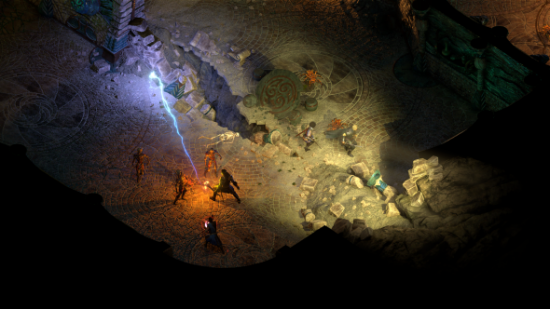A few years ago, Obsidian designer Josh Sawyer flipped a map of the Forgotten Realms’ Dalelands, stuck some different labels on it and named it the Dyrwood. One record-smashing Kickstarter later, he and his team had revived the spirit of the Baldur’s Gate games, with the wilderness exploration and spacebar-thwacking tactical combat intact.
Read more: the best RPGs on PC.
Fresh from another isometric RPG, Obsidian now intend to fold some of Tyranny’s reactivity and unfamiliarity into Pillars of Eternity II: Deadfire – a sequel as ambitious as Baldur’s Gate II was.
When is the Pillars of Eternity 2 release date?
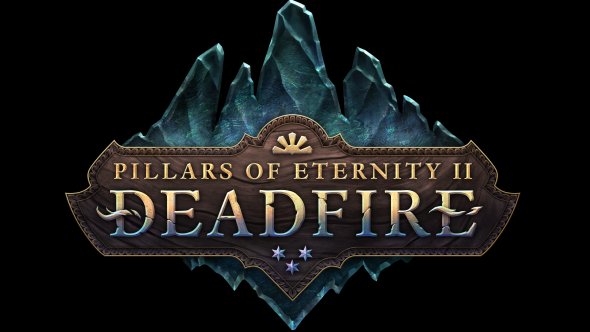
Pillars of Eternity 2 will release on May 8. Its first concrete release date was April 3,but that was pushed backso Obsidian could “polish and put those finishing touches on the game.”
The Fig crowdfunding site that helped finance the game originally suggested Q1 2018, so they’re only a couple of months behind schedule. It’s possibly a nerdy thing to say, but you’ve got to respect such tight project management.
What’s the story in Pillars of Eternity 2?
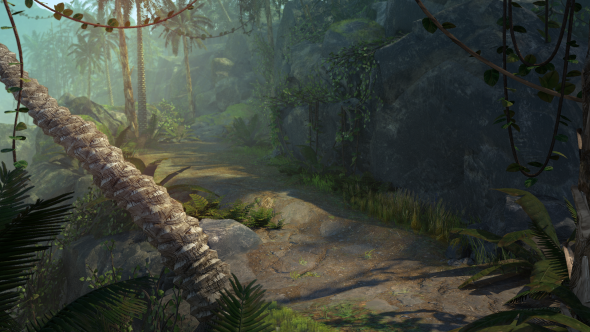
We’re going god-hunting. Eothas, the Eoran deity of light and rebirth, has inhabited the stone titan buried beneath the player stronghold Caed Nua for millennia. But now he’s awoken, tearing up through the earth, destroying the keep and half-killing you in the process.
The story of Deadfire, then, is a personal quest: to chase down Eothas, save your soul and find answers – answers which could “throw mortals and the gods themselves into chaos,” according to Obsidian.
Once again, you are the Watcher – a person gifted with the ability to see, speak with, and otherwise affect the souls of other people. No doubt this will continue to play a huge role in the plot, but Obsidian have kept any further details close to their chest.
Much like Mass Effect, you can import your save file from the original game, carrying over all circumstances and decisions that have echoes in the sequel. And if you don’t have such a file, you’ll even have the chance to customise those starting circumstances to your tastes.
Where is Pillars of Eternity 2’s setting?
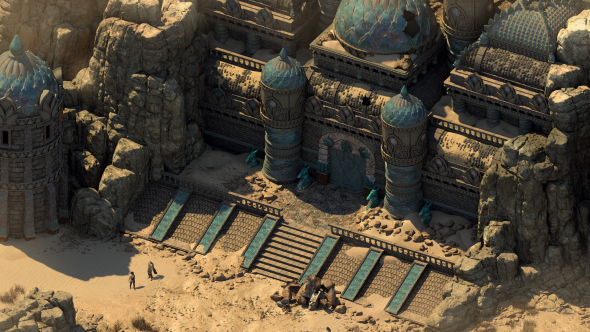
“If you’ve gotten tired of seeing temperate forests and meadows for 80 hours,” Josh Sawyer tells PCGamesN, “Let’s take a look at something else.”
Pillars 2 takes place in the Deadfire Archipelago – a smattering of small volcanic islands far to the south of the Dyrwood. Where Pillars 1 had a Middle Ages European vibe, the Deadfire more closely resembles the southern Pacific island chains of Asia.
“It has more of a Polynesian flavour, overall,” confirms Sawyer. “The climate is much different, the foliage you see is much different.”
The archipelago is in the process of being colonised, however – its islands are the only known source of luminous adra, which holds much larger amounts of soul energy than the Dyrwood variety. So you will see familiar faces and races – the humans and dwarves of Vailia, plus the Aumaua of Rauatai.
Here be monsters, too: deadly beetles, grubs, imps, dragons and snakelike naga – while out on the ocean to the east, terrible sea creatures cut short any explorative excursions. Not that players are likely to want for space to wander.
“It’s a big archipelago,” notes Sawyer. “It’s full of sea monsters, pirates and volcanoes, all sorts of crazy, crazy stuff.”
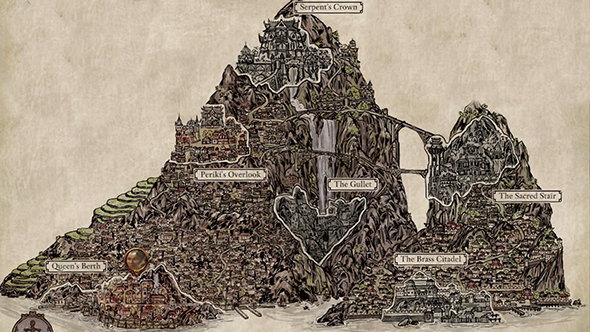
None of this means you won’t spend a fair bit of time on land, or indeed in a big city. Enter Neketaka, capital of the Deadfire Archipelago: a striking, vertiginous city that sprawls over a small island. It’s torn between the competing interests of trading companies looking to exploit the archipelago’s resources, and the locals looking to profit from their interest. Expect to see this competition reflected in the game’s faction system, and to have the chance to pick a side.
“We’re definitely trying to draw connections to things like the East India Trading Company, and various Belgian and Dutch trading firms as well,” Sawyer says. “Each of the colonial cultures has a different interest in the area. They overlap a little bit, and they are in direct competition.”
To learn more of Deadfire’s capital and its history, check out our guide to Neketaka.
What factions are in Pillars of Eternity 2?
The oldest humanoid culture on the islands are the Huana, a semi-nomadic set of aumaua tribes spread thinly throughout Deadfire. The tribes have shared traditions, and a caste system that forefronts warriors and priests.
But the Huana have few permanent settlements. Naasitaq, made up mostly of Boreal Dwarves and Aumaua, is the largest and most stable nation in the Deadfire islands. And a number of empires are at loggerheads over the archipelago, presenting Obsidian with plenty of opportunities to ask the player to take sides.
The pirates are a faction too, of course. A centuries-old dwarven lighthouse fortress that the locals call Balefire Beacon is now the keep of Captain Furrante – the spot from which he schemes and leads his crew in the Príncipi sen Patrena.
As for what form faction decisions will take, the dev team are looking toward the example set by last year’s Tyranny.
“In Pillars 1, we dropped the factions at the end of Act 2, and so [players] didn’t really feel like their choices were super significant,” admits Sawyer. “Something that I think Tyranny did much better, and something that we want to do for Pillars 2, is really establish the factions much more clearly – give the player clearer choices, and let them know when they’re approaching consequences for the choices they made.”
Who are the Pillars of Eternity 2 companions?
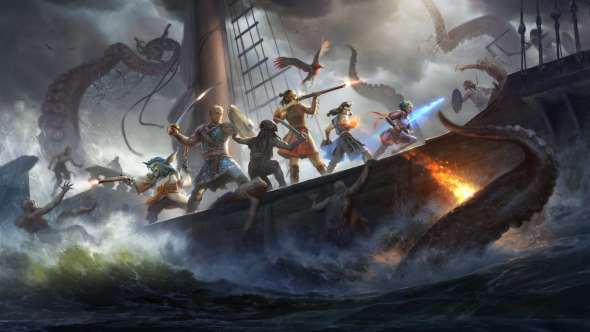
There are a total of seven companions for you to recruit in Pillars of Eternity II. Three are familiar faces: the human fighter Edér, wood elf wizard Aloth, and godlike paladin Pallegina. That leaves four newcomes: a harvest-wielding priestess of Gaun named Xoti, a bird-taming aumaua ranger called Maia, an orlan pirate by the name of Serafen, and a godlike druid named Tekēhu. And yes, you can now romance them – for all the details, check out our dedicatedPillars of Eternity 2 companion guide.
If you played the original game, then the returning characters will all be dealing with what happened last time you crossed paths.Each has different starting states depending on how you treated them. As Sawyer puts it: “If you made certain choices with them that took them in a bad direction, when they come back, they’re kind of screwed up.”
This includes getting them killed – did Edér die in the original? The sequel won’t resurrect him. If somehow you goteveryonekilled last time, you can build your own companions from scratch. Custom characters will be a little quieter and plainer than their fully scripted counterparts, but at least you can shape them to your whims.
Still, Obsidian are bullish about the pre-built cast. They say they are cognisant of the need to allow companions time to develop – giving them a longer stretch of the game to mature in their characters and relationships. At the beginning of production, Sawyer came up with a system to tag certain types of behaviour and attitudes in conversation – so that companions can react to them in the moment and over lengthier periods.
It’s that system we’ll be interacting with throughout Pillars 2, watching the evolution (or devolution) of companions’ relationships with the player and each other on the reputation screen. Some will build to break points, and those confrontations can be both good and bad for the party.
On the combat front, Pillars 2 won’t make use of the party combos that featured so heavily in Tyranny combat. There’s a reason for that: while Tyranny introduced a small number of companions who interlocked in very specific ways, Pillars will instead encourage players to experiment with its 11-class spread of abilities.
Pillars of Eternity 2 gameplay
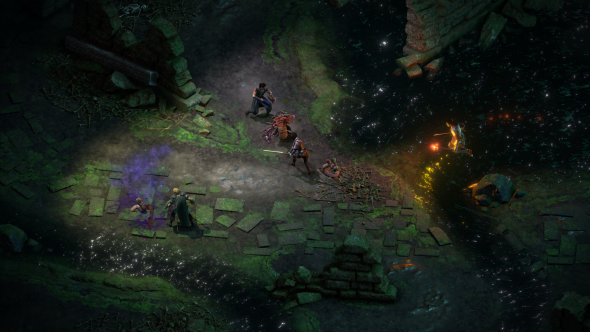
Remember the promises of Oblivion’s Radiant AI? We’re getting flashbacks. Obsidian say the people of Deadfire will have their own lives to live, jobs to carry out and appointments to keep – whether you’re there to precipitate events or not. Most intriguingly, they suggest that some quests will play out differently, depending on when and where their principal characters are approached.
Combat-wise, Pillars II is set to offer a little more tactical challenge than its predecessor – which was, frankly, more than tough enough for anyone without a solid grounding in the Infinity Engine games of old. Newcomers need not fear, though, since Obsidian plan to do a better job of communicating and tutorialising combat mechanics.
“With tabletop-style rule systems like this, there are so many layers of mechanics going on that are not visible by looking at the screen,” Sawyer explains. “We’re trying to make it easier to understand: clearer, better language. We’re just focusing on making sure that if you’re not familiar with this type of game, we’ll introduce concepts that are easy to absorb.”
So it’s about making things more readable, but no less deep: the team have no intention of reducing the statistical complexity that experienced Icewind Dale tacticians love to sink their teeth into. Those who really can’t stomach the battles can always retreat to the gentler Story Time mode, which makes a return.
One shift that will be immediately noticeable to everyone is the pace of combat. Pillars 1 included an option to slow down time to fight through some of the more intricate scenarios – and Obsidian have now made that the default speed, deeming it “more natural”. Players will, however, be able to toggle faster speeds for any battles they deem to be foregone conclusions.
The custom AI system in Pillars 1 has also had a thorough overhaul to address its limitations. In Pillars II, “if you want to customise your characters’ AI, you can go really, really crazy with it,” Sawyer says. “If you liked the Final Fantasy gambit system, or the AI settings from Dragon Age Origins, those are the games we used as inspirations.”
The gambit system was awesome, so this is exciting to hear. If you don’t fancy fiddling around with prioritising three different actions for each character when an ally’s HP reaches
Pillars of Eternity 2 classes
Pillars of Eternity embraced a maximalist vision of role-playing, stuffing 11 classes into its combat system. That system is set to be complicated further by the delicious possibilities of subclassing and multiclassing.
If you’ve played any Baldur’s Gate 2, you’ll be familiar with how subclasses work – you can pick just one, optionally, and it makes you even further specialised. In each case, there’s a benefit and a trade-off.
The Ghost Heart Lodge ranger, for instance, has a deceased animal companion who shows up as a spirit during combat. The furry spook is immune to druid spells, but susceptible to banishment by paladins. Monks of the Nalpazca, meanwhile, are drug-addled philosophers who benefit more from the effects of stimulants, but suffer increased wound thresholds while high.
Multiclassing also functions in a manner not too far removed from Baldur’s Gate-era D&D – allowing you to select an additional class from second level onwards, gaining a new title in the process. A fighter who takes a couple of levels in wizardry, for example, becomes a battlemage. From there you can alternate between classes whenever you level.
“We want to keep the relative power of the multiclass character at about 75%-85% what a single class character would have at any given level,” says Sawyer. “In our experience, that’s the sweet spot where multiclass characters feel powerful and effective, but don’t clearly outshine the single class characters.”
Finally, it’s worth noting that every companion can now be one of two base classes.
“That way you don’t have redundancies where you want to play a fighter, and right away you get a fighter [companion],” furthers Sawyer. “You can say, ‘No, I want you to be a rogue. Complement me, don’t replicate me.’”
Pillars of Eternity 2 ships
A stretch goal for the Project Eternity Kickstarter promised a stronghold that players could take control of as a part-time baron. And while that did appear in Pillars, the team felt frustrated they didn’t have more resources to dedicate to that corner of the game.
Obsidian wanted to give you a better base in the sequel, and so they have: you get your very own ship. Your starting model is a modest boat named The Defiant, but you can acquire bigger and better vessels throughout the game, as well as refit, rename, and otherwise customise them.
You’ll also need to consider your staff: you can recruit crewmen, each with their own skill ratings governing, say, how quickly they can reload a cannon. Intriguingly, they’ll also have personality traits, which might affect how they behave in a crisis, or how well they gel with the rest of the crew. You’ll also need to keep them happy or else face mutiny: feed them, pay them, let the believers among them pray, and manage the occasional crisis to everyone’s satisfaction.
Speaking of which, life at sea is, famously, hazardous. While you’re exploring the Deadfire archipelago, enjoying that satisfying process of filling in the map, you’ll contend with a number of threats. Enemy ships, piratical or otherwise, are the most obvious of these – you’ll defend yourself in a deep, turn-based combat system, with illustrative art and text describing what the enemy is doing, and your own options.
To learn more about all these systems, check out our Pillars of Eternity 2 ship combat and customisation guide.
Pillars of Eternity graphics
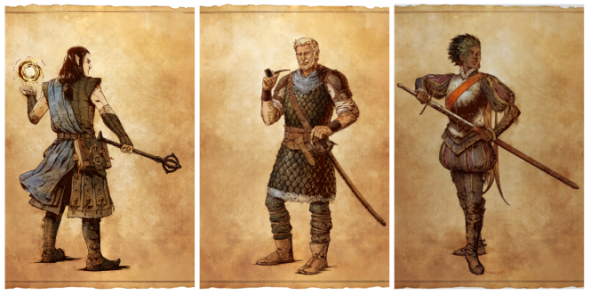
Pillars of Eternity found the Black Isle veterans at Obsidian relearning the art of 2D backgrounds – much like Disney, digging out the mothballed tools of traditional animation for The Princess and the Frog. Now, though, they’ve hit their stride.
“There’s so much stuff we’re pushing in terms of new 3D stuff within that 2D space,” Sawyer says. “It’s crazy sometimes now to go back and look at the stuff in Pillars I, which I still think looks nice, but looking at Pillars II and the technological jumps that we’ve done is pretty incredible. We’re just doing stuff that no one else is doing.”
Obsidian artists have put together a new dynamic weather system, parallax backgrounds, antialiasing and “various fancy shaders” – meaning better-looking water, ice, and crystalline adra. Character lighting and reflection is far more advanced, too, which will pay off in those dense jungles.
It’s all folded into the game in sensible and subtle fashion:
“VFX in PoE1 often dominated the screen and made it difficult to assess the battlefield,” admits lead artist Kaz Aruga. “For Deadfire we are being mindful of this fact and developing our spell effects in a way that minimizes this issue.”
Pillars of Eternity 2 level cap
Pillars of Eternity 1, with its White March expansion, topped off at level 16. Deadfire will raise that to 20, which is high enough to grant extra levels of abilities for all classes.
Although it’s worth importing your saves to see the knock-on effects of the choices you made in the Dyrwood, none of your levelling will come with you. In Deadfire, the player character begins again at level 1.
“Eothas is very hungry and your soul is delicious,” explains Sawyer.
No grumbling, now – it means you get to experiment from scratch with the subclass and multiclass systems new to the sequel. Intriguingly, Obsidian are also implementing a New Game+ feature called ‘Berath’s Blessings’, which gives players bonuses when they start a new playthrough, based on achievements in previous saves.
The Blessings take the form of points which can be spent on a variety of unlocks – better starting gear, higher attributes, more cash, that sort of thing. The unlocks also cover more specific options like beginning with a favourite companion, or bonus faction reputation – letting veterans skip past parts of the game they can’t be bothered with a second time.
